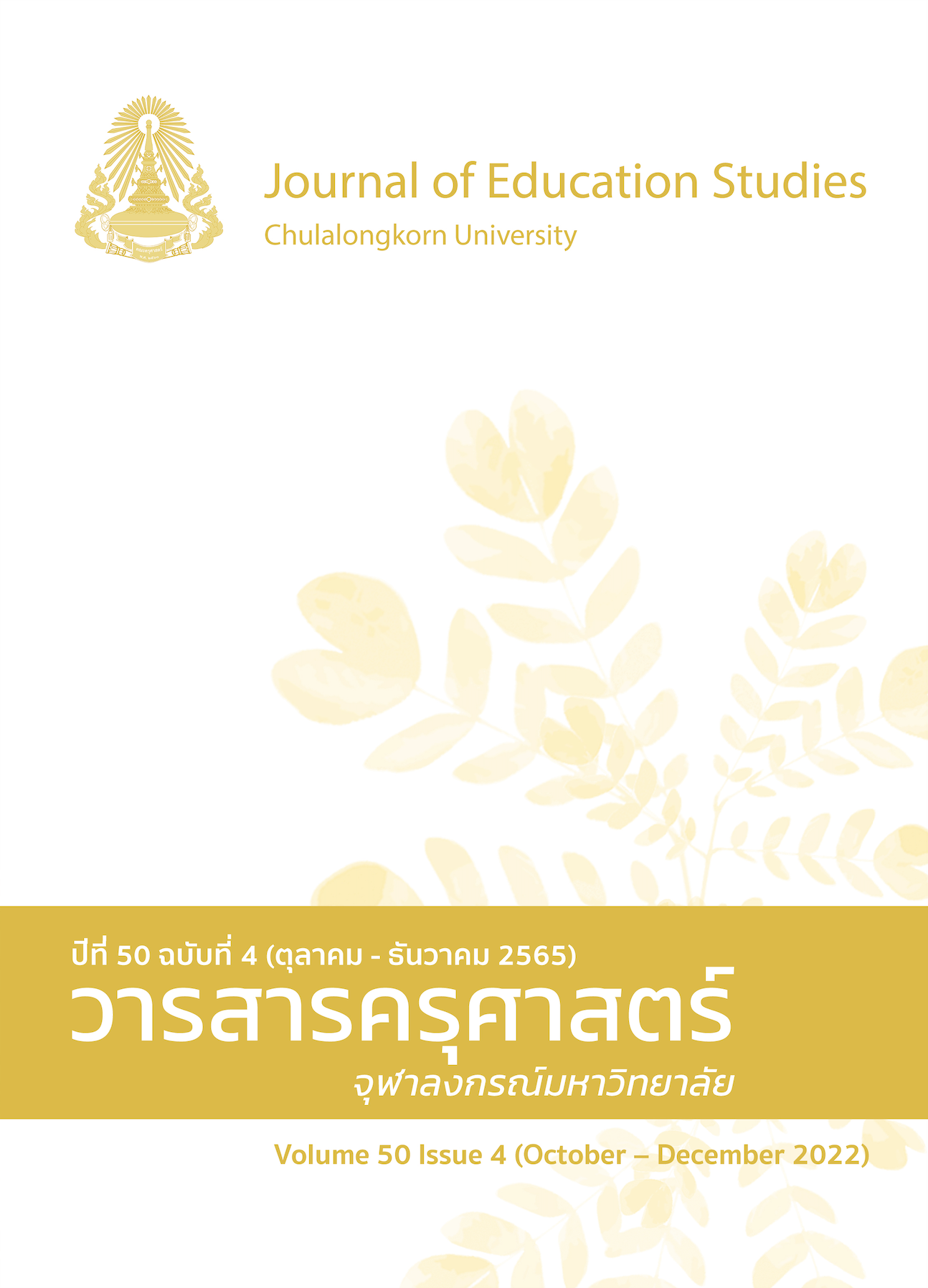The Guidelines for Developing Board Game to Promote Effective STEAM Instruction Design and Educational Board Game Design Canvas
DOI:
https://doi.org/10.14456/educu.2022.35Keywords:
board game, educational board game, STEAM educationAbstract
This research aimed to 1) study the guidelines for developing board game to promote effective STEAM instruction design and 2) develop an educational board game design canvas. The samples were 15 board game products. The instruments used in this research were 1) matrix analysis, 2) image scale, and 3) a board game design process analysis table. Data were analyzed by using descriptive statistics and content analysis, and then used to synthesize the results as follows. 1) the guidelines for developing board game to promote effective STEAM instruction design. The board game should promote the development of all 4C skills, which consist of critical thinking, communication, collaboration, and creativity, especially critical thinking and creativity skills. The optimal duration for the game is 60-90 minutes, and the ideal number of players should be more than 4 players. The product position in the image scale should be between Group 2 "skill building" and Group 4 "collaborate to solve problems". 2) The educational board game design canvas can be divided into components as follows: 1) "Research" includes 1.1) content 1.2) concept 1.3) players 1.4) market research 1.5) player experience. 2) "Design" includes 2.1) theme 2.2) mechanics 2.3) components 2.4) look and feel 2.5) game flow summary. 3) "Development" include 3.1) playtest.
References
ภาษาไทย
พีรัช ษรานุรักษ์. (2565). สร้างทักษะสำคัญผ่านบอร์ดเกม “Board game play to learn”.
https://www.bangkokbiznews.com/biz2u/1006632
รัชกร เวชวรนันท์. (2563). กระดุม 5 เม็ดของการออกแบบบอร์ดเกมการเรียนรู้. https://www.bosslabboardgame.com/post/กระด-ม-5-เม-ดของการออกแบบบอร-ดเกมการเร-ยนร
สำนักงานนวัตกรรมแห่งชาติ. (2564). STEAM4INNOVATOR Playroom.
https://www.youthinnovation.org/2021/steam4innovator-playroom-application/
TK Board Game Club. (2560). ข้อแตกต่างของบอร์ดเกมยุคเก่ากับยุคใหม่. https://www.tkpark.or.th/download?
file=0037f7.pdf&name=BoardGame-02.pdf
ภาษาอังกฤษ
Becker, K. (2021). What’s the difference between gamification, serious games, educational games, and game-
based learning?. Academia Letters.
Beltrami, D. (2020). A board game design process: A game is a system. https://uxdesign.cc/
a-board-game-design-process-a-game-is-a-system-5469dfa4536
Brian, M., & Christopher, H. (2010). Libraries got game: Aligned learning through modern board games (ALA
Editions ed.). https://chula.idm.oclc.org/login?url=https://search.ebscohost.com/login.aspx?direct=
true&db=nlebk&AN=308784&site=eds-live
Creighton, S., & Szymkowiak, A. (2014). The effects of cooperative and competitive games on classroom
interaction frequencies. Procedia - Social and Behavioral Sciences, 140, 155-163.
https://doi.org/10.1016/j.sbspro.2014.04.402
Despeisse, M. (2018). Teaching sustainability leadership in manufacturing: A reflection on the educational
benefits of the board game factory heroes. Procedia CIRP, 69, 621-626.
https://doi.org/10.1016/j.procir.2017.11.130
Jho, H., Hong, O., & Song, J. (2016). An analysis of STEM/STEAM teacher education in Korea with a case study of
two schools from a community of practice perspective. EURASIA Journal of Mathematics, Science & Technology
Education, 12(7), 1843-1862. http://dx.doi.org/10.12973/eurasia.2016.1538a
Jung, S. H., & Chan, J. P. (2020). Research analysis on STEAM education with digital technology in Korea to prepare
for post-corona era education. International Journal of Contents, 16(3), 101-110.
https://doi.org/10.5392/IJoC.2020.16.3.101
Nam, H. K. (2019). A review of the effect of integrated STEM or STEAM (science, technology,
engineering, arts, and mathematics) education in South Korea [article]. Asia-Pacific
Science Education, 5(1), 1-22. https://doi.org/10.1186/s41029-019-0034-y
Pope, L. (2021). Board games as educational tools. http://www.susted.com/wordpress/content/board-games-as-
educational-tools_2021_05/
Sousa, M., & Bernardo, E. (2019). Back in the game: Modern board games. In N. Zagalo, A. I. Veloso, L. Costa, & O.
Mealha. (Eds.). Videogame Sciences and Arts 11th International Conference, VJ 2019, Aveiro, Portugal (pp. 72-
. https://doi.org/10.1007/978-3-030-37983-4_6
Stegmaier, J. (2020). 10 steps to design a tabletop game (2020 version). Stonemaier Games,.
Taha, F., Hockaday, S., & Jarvis, T. (2017). Serious gaming in water. Mediate: Everything Mediation.
https://www.mediate.com/articles/HockadayS1.cfm
Wirtz, B. (2022). How to create a board game, The Smart Way. https://www.gamedesigning.org/
learn/board-games/
Wizards of learning. (2022). Share 5 process of how to design board games. https://wizardsoflearning.com/share-
how-to-design-procress-board-game/
Yakman, G. (2008). STEAM education: An overview of creating a model of integrative education.
https://www.researchgate.net/publication/327351326_STEAM_
Education_an_overview_of_creating_a_model_of_integrative_education
Žavcer, G. (2014). Design pattern canvas: An introduction to unified serious game design
patterns. Journal Interdisciplinary Description of Complex System, 12, 280-292.
Downloads
Published
How to Cite
Issue
Section
License

This work is licensed under a Creative Commons Attribution-NonCommercial-NoDerivatives 4.0 International License.




